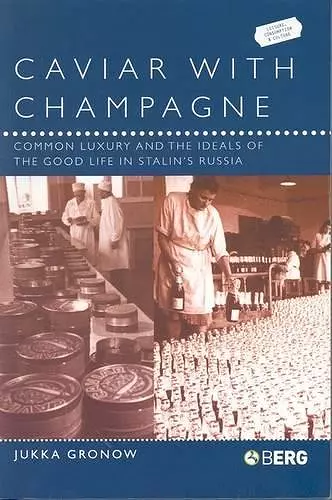Caviar with Champagne
Common Luxury and the Ideals of the Good Life in Stalin's Russia
Format:Paperback
Publisher:Bloomsbury Publishing PLC
Published:1st Oct '03
Currently unavailable, and unfortunately no date known when it will be back

Also available in hardback, 9781859736333 GBP50.00 (October, 2003)
Stalin's Russia is best known for its political repression, forced collectivization and general poverty. This work presents a different aspect of Stalin's rule - the creation of a luxury goods society.'Life has become more joyous, comrades.' Josef Stalin, 1936Stalin's Russia is best known for its political repression, forced collectivization and general poverty. Caviar with Champagne presents an altogether different aspect of Stalin's rule that has never been fully analyzed - the creation of a luxury goods society. At the same time as millions were queuing for bread and starving, drastic changes took place in the cultural and economic policy of the country, which had important consequences for the development of Soviet material culture and the promotion of its ideals of consumption.The 1930s witnessed the first serious attempt to create a genuinely Soviet commercial culture that would rival the West. Government ministers took exploratory trips to America to learn about everything from fast food hamburgers to men's suits in Macy's. The government made intricate plans to produce high-quality luxury goods en masse, such as chocolate, caviar, perfume, liquor and assorted novelties. Perhaps the best symbol of this new cultural order was Soviet Champagne, which launched in 1936 with plans to produce millions of bottles by the end of the decade. Drawing on previously neglected archival material, Jukka Gronow examines how such new pleasures were advertised and enjoyed. He interprets Soviet-styled luxury goods as a form of kitsch and examines the ideological underpinnings behind their production.This new attitude toward consumption was accompanied by the promotion of new manners of everyday life. The process was not without serious ideological contradictions. Ironically, a factory worker living in the United States - the largest capitalist society in the world - would have been hard-pressed to afford caviar or champagne for a special occasion in the 1930s, but a Soviet worker theoretically could (assuming supplies were in stock). The Soviet example is unique since the luxury culture had to be created entirely from scratch, and the process was taken extremely serio
'Jukka Gronow describes the development in the hungry 1930s of a Soviet rhetoric of cultured living that privileged luxury commodities like champagne, caviar and perfume ... The thorough research in the archives it is based on makes Caviar with Champagne useful to scholars, and general readers will enjoy its vivid illustrations.'London Review of Books 'Jukka Gronow has applied his mastery of the every-day economy and taste cultures to the bewildering world of Stalinist consumerism. In an engaging style, he expertly explains how a luxury goods market came about in a socialist state in the midst of widespread poverty in the 1930s. Both Russians and foreign visitors familiar with Sovetskoe Shampanskoe and the old Soviet department stores and food and fashion shops will enjoy a thrill of discovery about their origins.' Richard Stites, Professor of History, Georgetown University'An excellent and innovative contribution to the study of consumer culture. By exploring in detail the
ISBN: 9781859736388
Dimensions: 234mm x 156mm x 13mm
Weight: 328g
256 pages